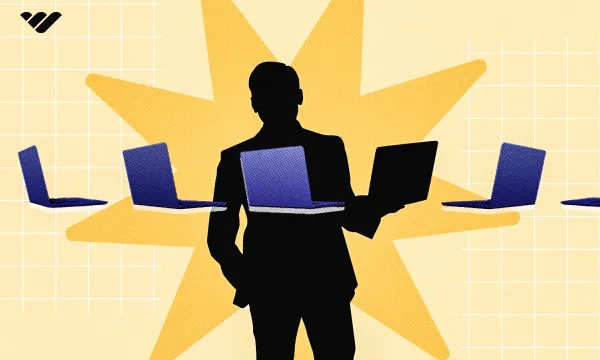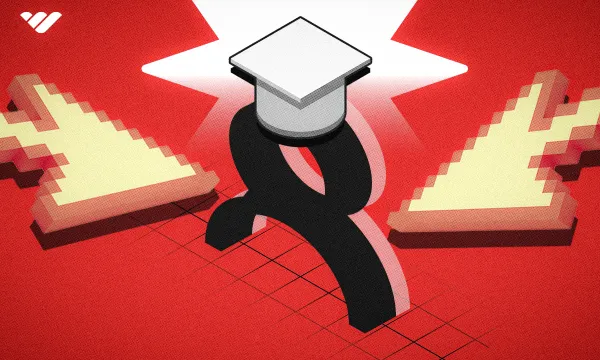Picture this: You have a friend who makes the best chocolate chip cookies in the world and she starts selling them. She prices them at $5 and makes you an offer—for every customer that you bring to her, she will give you $0.25.
You think to yourself “That’s 5%? That doesn’t seem like a lot if I’m making her $5!”
Well, oftentimes that’s what happens in affiliate marketing. An affiliate (the person bringing brand new customers) only gets a small percentage of the revenue they generate. But high-ticket affiliate marketing is different - same concept, much higher earning potential.
In this guide, we’re going to discuss what high-ticket affiliate marketing is, examples of programs you can join, and why you should consider getting started with it.
What is High-Ticket Affiliate Marketing?
High-ticket affiliate marketing is when you promote products and services that have a higher commission than traditional affiliate programs. These commissions are typically hundreds of dollars, not a few bucks.
Before we dive into the thick of it, here are a few terms that you should know when discussing high-ticket affiliate marketing:
- Customer acquisition cost (CAC): How much it costs a brand to acquire a new customer
- Lifetime value (LTV): How much a customer will spend at a brand throughout their life, or, how much one customer is worth to a brand in terms of revenue
- Product-market fit: The relationship between a good for sale and the target demographic that uses it
- Commission: The percentage or flat amount that an affiliate is paid by the brand for new sales
- Affiliate: The person promoting a brand, product, or service
- Advertiser: The company that owns the product or service being promoted by affiliates
For context, in traditional affiliate marketing, the affiliates (creators, influencers, bloggers, YouTubers, etc.) are paid a percentage of how much they generate in sales. This can be referred to as “revshare” or “revenue share.” These commissions are typically anywhere from 5% to 20%.
High-ticket affiliate commissions are often worth $100s.
So, why is this the case? These affiliates are usually promoting products like apparel, footwear, accessories, or gear. And because these are items that are purchased only once in a while—versus a software subscription like Netflix or a supplement brand like Athletic Greens—the company can only afford to pay them a small percentage of the sale. There’s no recurring revenue coming in.
But, with high-ticket affiliate programs, affiliates are partnering with brands that have product-market fit, their numbers are dialed in, and their fulfillment operations are seamless. This allows the advertiser to offer a higher commission because they fully understand their CAC across all of their marketing channels and, most importantly, they know their LTV which allows them to ideally spend more to acquire that customer.
The better the product, the better the business, and the better the numbers, which makes advertisers able to give affiliates more commissions.
High-Ticket Affiliate Marketing vs. Traditional Affiliate Marketing
One thing to note is that high-ticket affiliate marketing campaigns are typically business-to-business products, not consumer products. This is because professional services are able to charge several hundreds of dollars per month, which isn’t the case with consumer products.
Since a tool like Slack or Shopify is used by a business that’s helping them generate thousands of dollars each month, the companies that use them are able to invest more in the software. But, the average person probably can’t afford to pay hundreds of dollars on subscriptions like Netflix or Spotify each month.
This isn’t a hard-and-fast rule, but high-ticket affiliate campaigns are typically for business customers, which means that the content your produce or ads you run should be targeted toward entrepreneurs and managers, not everyday people. Think deep, informative videos versus fun, entertaining lifestyle content.
Three Examples of High Ticket Affiliate Marketing Programs
Let's take a look at some high ticket affiliate marketing programs in action. Here are three popular examples and how they work.
🥇 1. Whop Affiliates
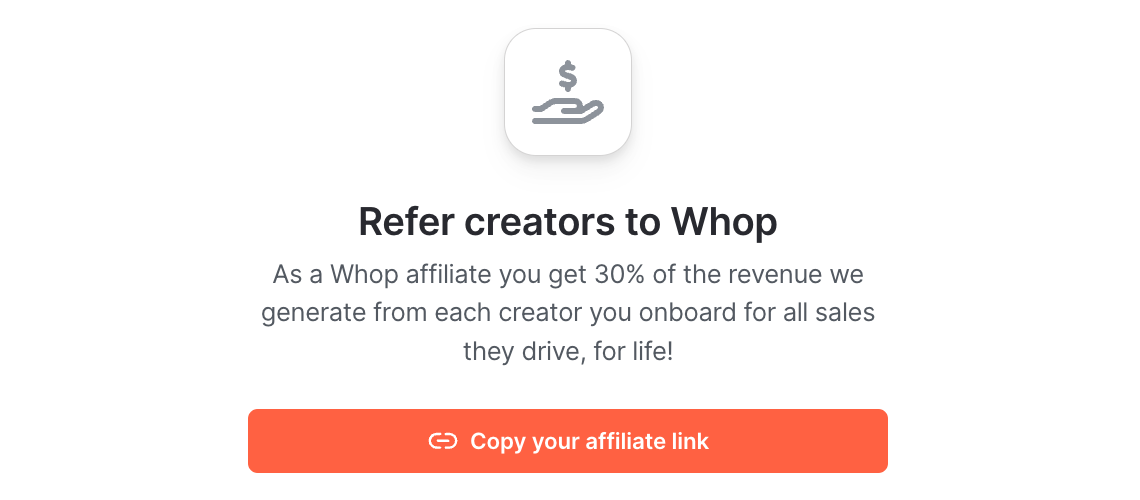
Whop is a social commerce platform made for creators, by creators. It helps thousands of creators earn over $2000 a month by selling digital products and services online, and the platform takes a percentage of creator revenue. Whop has a very generous affiliate program, where if you refer a creator to Whop, you net 30% of Whop's revenue. So when a creator sells a product, Whop takes a percentage, and you take 30% of that percentage.
The best part? This is recurring revenue for life. For every single sale the creator makes, you take a cut of that! It doesn't stop with one customer - you get paid again and again and again, for as long as the creator remains on Whop. So far, affiliates have earned more than $8 million.
Explore the Whop affiliate program.
2. Shopify Affiliate
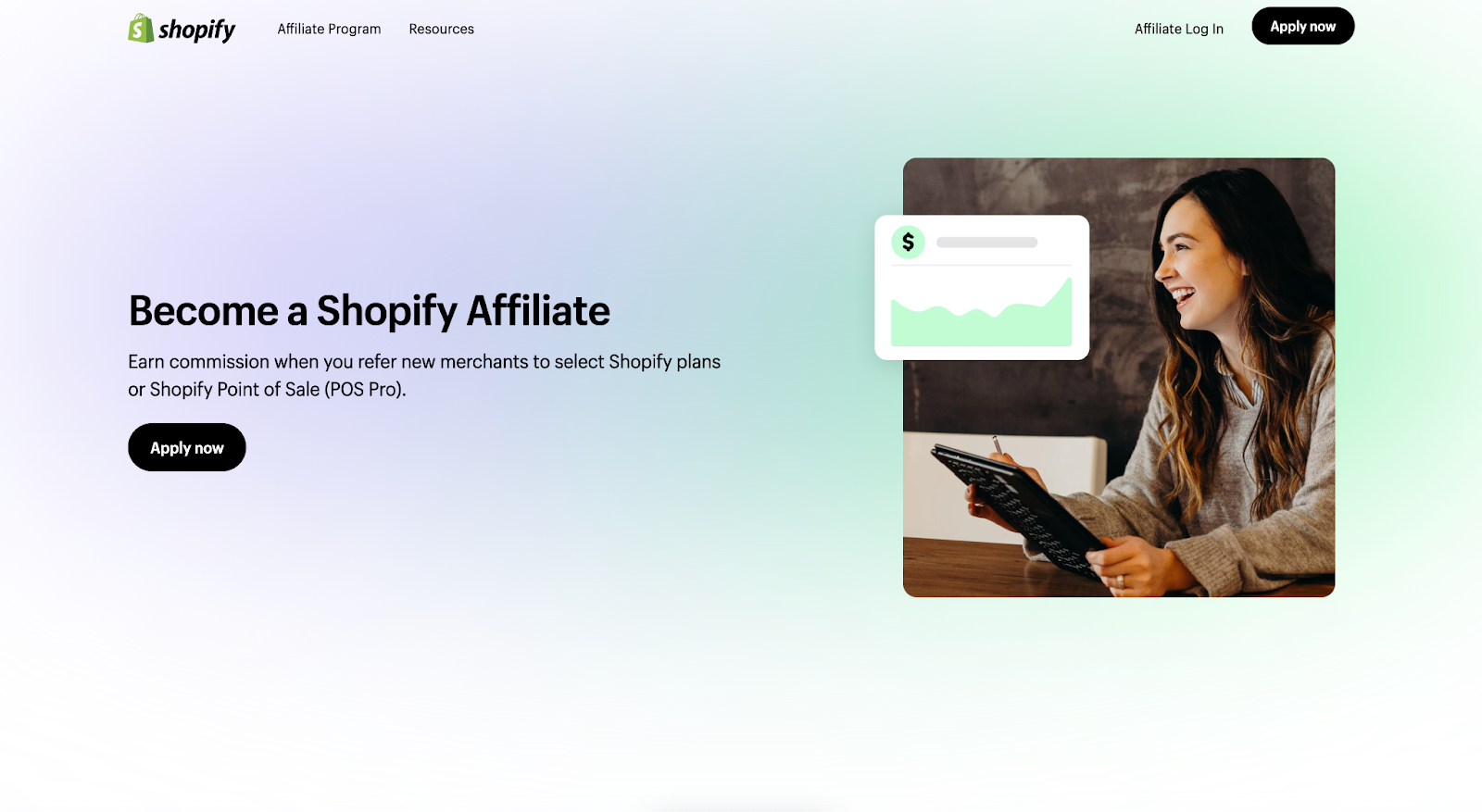
The ecommerce giant allows entrepreneurs to build their own websites and sell products online. They make money through a monthly subscription and credit card processing fees, which allows them to pay affiliates great commissions. Commissions range from $25 to $150.
3. Semrush
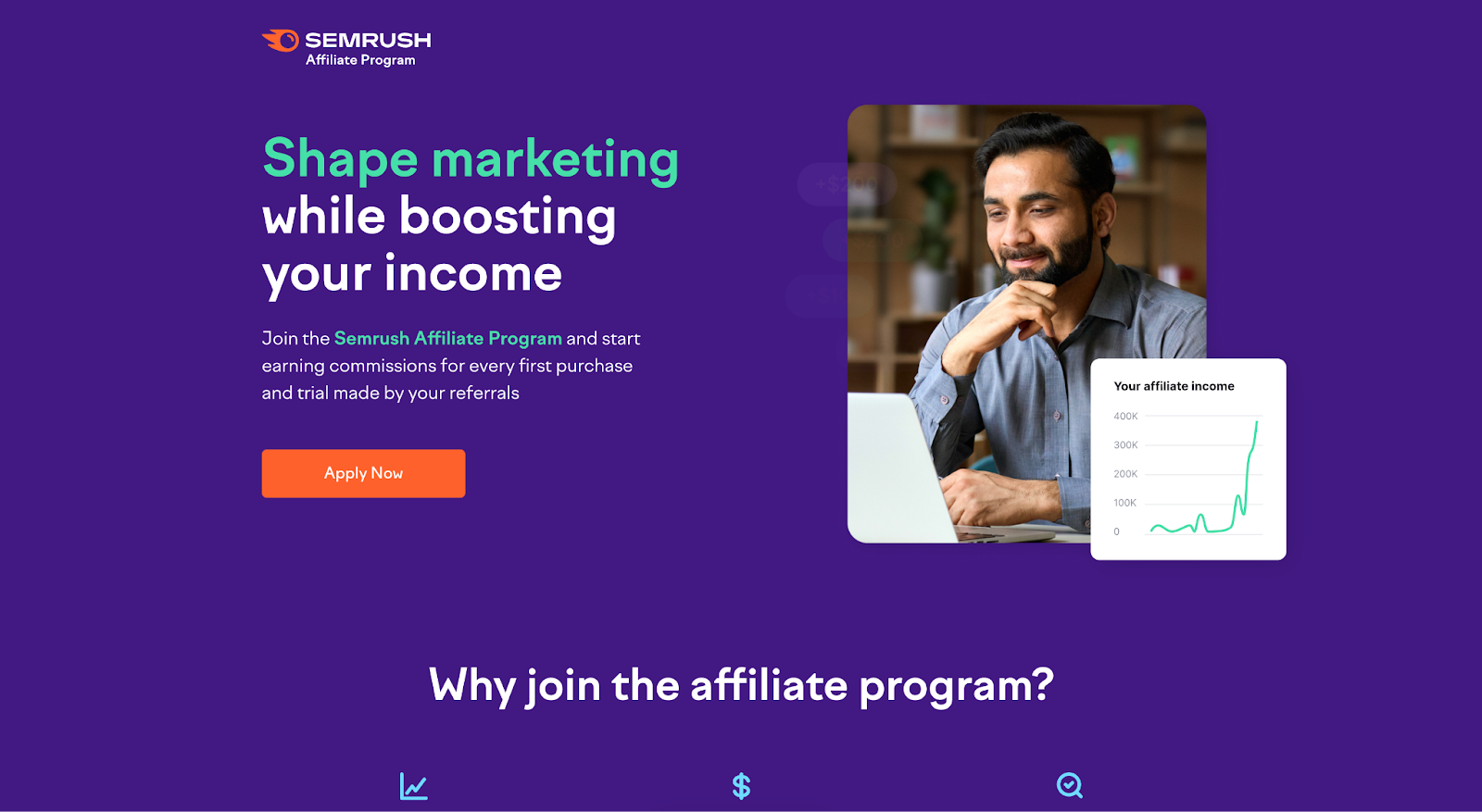
This software helps bloggers do keyword research to generate traffic to their site from search engines. Customers who use Semrush are able to pay large amounts for the tool because their whole business revolves around SEO. Commissions range from $10 per trial sign-up to $200 per paying customer.
25+ High-Ticket Affiliate Programs To Turbocharge Your Earnings.
Pros and Cons of High-Ticket Affiliate Marketing
Now that you know what high-ticket affiliate marketing is and how it works, let's look at some of the best and worst parts of this type of marketing.
Pros:
- Higher Payouts
The biggest benefit of high-ticket affiliate marketing is that it has a… high ticket. Rather than getting a small percentage of the revenue you bring in, you typically receive a set flat amount in the $100+ range.
This means that you can get fewer customers and still make a good income. - More Established Brands
Because the advertisers that you’re working with have a fully developed sales “funnel” (the process of bringing in a new customer), they have more systems and operations to help you. You may be working with startups, but they have a strong foundation to help your marketing efforts scale. This makes your campaigns run smoother, you’ll get paid faster, and ultimately, you’ll make more money. - Potential for Long-Term Commissions
Some companies that are on a subscription basis will offer affiliates not just a one-time commission, but a recurring payment for each month that the customer stays on. This means that you could bring a customer in one time but still get paid each month. - More Niche Content
Most high-ticket campaigns will be in specific verticals like ecommerce or productivity. The content you create has to be tailored to people who would find these tools useful.
Although it may make things harder or more targeted at first, if you’re truly a subject matter expert then you’ll enjoy making this type of content because it’s something that you’re well versed in.
Not to mention, fewer people will be able to compete with you. - Multiple Options to Monetize
Not all payouts and conversions are just when a customer signs up for a subscription. Some events, such as someone signing up for a free trial, could still be counted as a conversion. Alternatively, conversions may not be tracked until a customer does a specific action such as “gets 10 sales” or “stays on for six months.”
The more difficult the event, the higher the payout. But regardless, you have more options. Campaigns that only require someone to enter their contact information or sign up for a trial are referred to as “cost per lead” (CPL) campaigns and are usually for more expensive products like a mattress or car.
Cons:
- Higher Customer Acquisition Costs
Because the price (or average order value) of the product is higher, you need to spend more money or time to acquire them. You have to create more content or spend more money on ads so that your target audience sees the product multiple times. They probably won’t hit “buy now” the first time they see something. - More Competition
More money, more problems. Since the opportunity for higher payouts is in this form of affiliate, some of the best marketers and operators are trying to cash in.
If you’re a complete beginner, take this into consideration. Additionally, advertisers may not let you join their program as an affiliate if you don’t have a track record of success promoting other people’s products. - Expiration on Programs and Lowered Payouts
One of the most overlooked aspects of high-ticket affiliate programs is the lifespan of campaigns. The earlier a business is into its journey, oftentimes the more money it will be willing to spend on commissions because it’s still in the phase in which they’re looking for early customers and product-market fit.
What this means is that as the company matures, they’ll scale back on how much commission they offer because they have a more omni-channel marketing strategy and better brand recognition. This is always going to happen—there could be cases in which a company ends up paying more the more it grows, but this is what happened with Shopify, for example.
YouTubers who were early to promote Shopify as the best ecommerce tool received much more lucrative commissions compared to today’s rates. - Longer Consideration Cycles
The customer that purchases a high-cost B2B software is going to take a longer time to become a customer than someone who is simply buying a new t-shirt. This could cause a few problems: First, tracking could be more disjointed, so you could lose credit for sales; second, your feedback loop is longer so you don’t know exactly what marketing angles are working more than others; and third, you could potentially run into cash flow problems if you’re traffic source requires paid media.
High-Ticket Affiliate Marketing for Beginners: How to Start Earning Big!
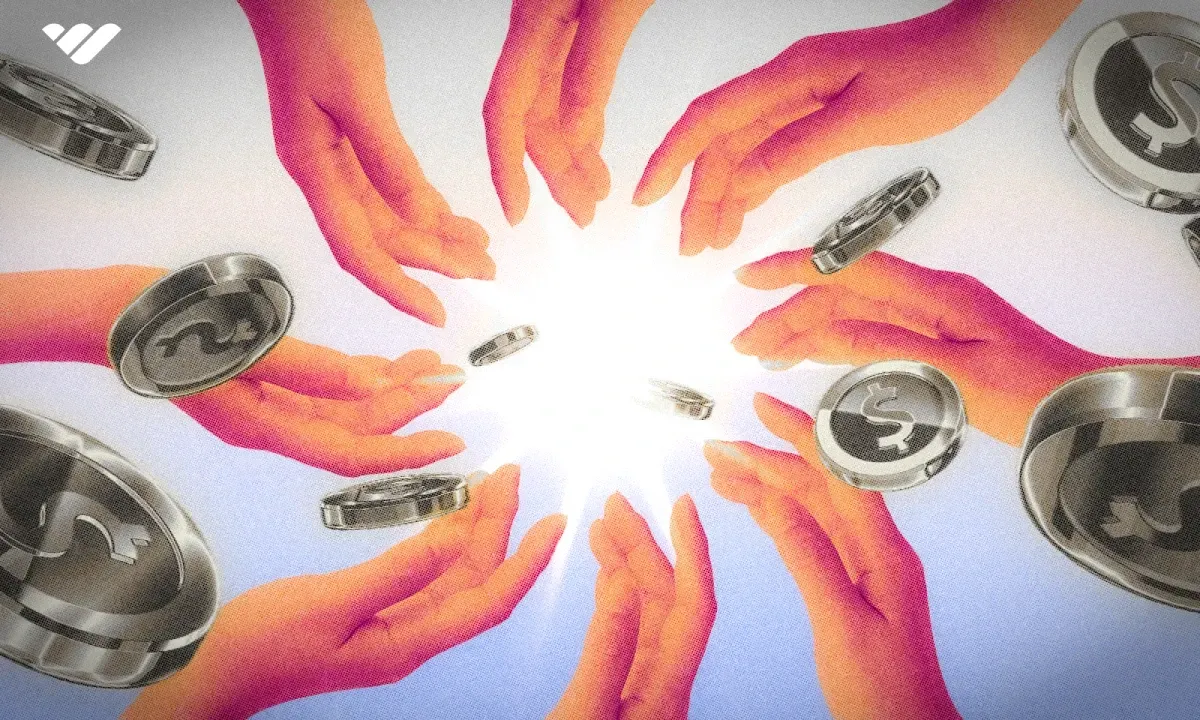
Here are a few simple steps you can take to get started with high-ticket affiliate marketing:
Grow (or Buy) an Audience
In order to get customers, you need to have traffic. Traffic can be generated in two forms: Organic and paid. Organic traffic is typically found through posting content on a platform like YouTube or TikTok and paid traffic is through ads run on Google, Instagram, and more.
Organic traffic is cheaper, but it takes your time. Paid traffic costs money by definition, but you can reach a much greater scale. Consider posting content within a specific niche that you have a lot of knowledge on.
Explore & Apply to Affiliate Marketing Programs
Once you’re getting eyeballs, it’s time to start looking at different affiliate programs and applying. You can find different advertiser affiliate programs on platforms such as Impact, Commission Junction, and Awin. You can apply to join the program on these websites, which will also manage your payments.
Create Content Across Multiple Channels
Now that you’ve joined a few affiliate programs and have at least one channel working for you, you should start to diversify. You never know when a platform could make a change to the algorithm that could lose you followers or reach, so it’s best to be active on multiple platforms to ensure your business’s sustainability.
Reinvest Your Profits
You’ve started generating sales, but what do you do next? You’re likely not reaching your full earning potential at this stage yet, so one of the best things you can do is reinvest the money that you’re making back into your business. This could look like starting ad campaigns for other advertisers or hiring a team to help you make more content.
Repeat and Scale
At this point, you may have several campaigns that are working and you’re looking to make even more money. Now is when things really get fun! Use the same things that got you to this point to scale even higher. Join more programs, create more content, and make more money.
Looking to Earn Passive Income? Look No Further than Whop!
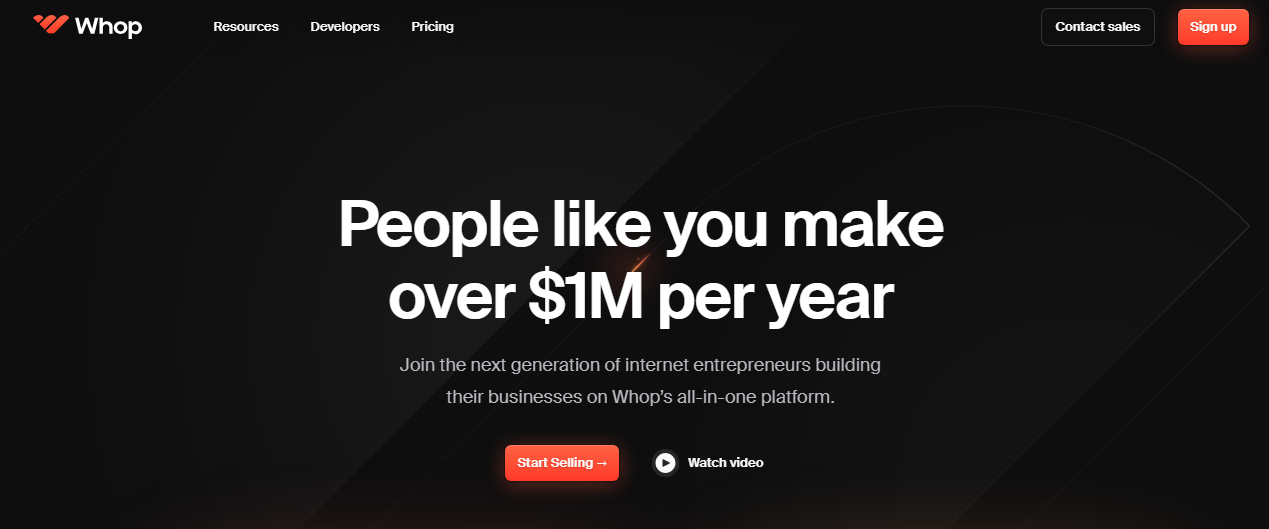
If you like the idea of making money online without the need for an office, reporting to a boss, or constantly having to communicate with clients, then Whop is the place to start. Not only do we have an excellent affiliate marketing program, but we are in the business of monetization, so anyone, anywhere can make money with Whop.
If you're just starting out then we have thousands of communities and courses that will help you in your internet entrepreneurship journey. Whether it’s high-ticket affiliate marketing, dropshipping, running a paid community, or anything else, our marketplace will have a place for you.
Or, if you have experience in anything (yes, anything) then why not create your own paid community, course, or digital product with Whop?
Create your whop, add the products you want to include (like a community chat, course, ebook, downloadable files, video calls app - the list goes on!) and start sharing your skills and knowledge with the world. From real estate mentors to sports cappers, to digital nomads and even fitness creators, there are all kinds of creators making money by sharing their skills on Whop. It takes just minutes to get started, and it won't cost you a cent - we take a small 3% of your sales + transaction fees.
High-Ticket Affiliate Marketing FAQs
How Much Do High-Ticket Affiliate Marketers Make?
There’s no set amount that high-ticket affiliate marketers make. It all depends on what programs you join, how much you can scale your campaigns, and how savvy you are at marketing. Some high-ticket affiliate marketers are making zero dollars while some are making millions.
What are the Most Popular High-Ticket Affiliate Marketing Programs?
Some of the most popular high-ticket affiliate programs are HubSpot, WP Engine, Shopify, and Kinsta. These are all technology products that charge business customers a high rate to use them on a monthly basis.
Who is the Most Successful Affiliate Marketer?
It’s almost impossible to definitely recognize the most successful affiliate marketer, as most “super affiliates” aren’t public and the most successful affiliates don’t disclose their revenue. However, some of the biggest names in the space are Anthony Sarandrea, Adam Young, Matt Diggity, and Chris Erthel, to name a few.
Why Should I Start High-Ticket Affiliate Marketing?
High-ticket affiliate marketing isn’t for everyone, but if you have a keen understanding of software products and a large following on a social media following, or can efficiently generate traffic, you should consider high-ticket affiliate marketing.


![40 Easy Ways to Make Money Online [2024]](/blog/content/images/size/w600/2023/11/20-ways-to-make-money-online--1-.webp)
